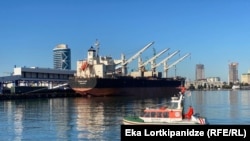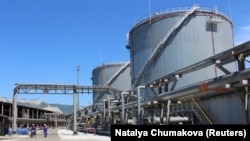The bulk of Armenia’s commerce with Russia, its number one trading partner, is carried out through the sole Russian-Georgian border crossing at Upper Lars. A mountainous road passing through Upper Lars is periodically closed due to blizzards and landslides, causing Armenian companies serious losses. It has also become increasingly congested in recent years.
The Armenian Ministry of Economy hired a foreign sea freight company last year to operate a new ferry link between the Georgian Black Sea port of Batumi and Russia’s Novorossiisk that was supposed to be an alternative to Upper Lars. The company, C&M International, launched it in the summer after being paid 500 million drams ($1.2 million) by the ministry.
“The ferry operated for several months but … did not generate sufficient interest from exporters and importers,” Kerobian told reporters this week. “We did not see export and import companies use the ferry in a way that could convince us and our partners to continue the project.”
The minister contradicted his own remarks on the issue made less than three months ago. “The project is working as we see strong interest from [trading] companies,” he said at the time.
Speaking to RFE/RL’s Armenian Service, multiple cargo company executives in Yerevan said a key reason for the failure of the Batumi-Novorossiisk service is that it involved a typical cargo ship, rather than a real ferry. This means that commercial trucks were unable to board the ship and proceed to the Russian port or vice versa by sea and instead had to load their cargo onto it.
Russian-Armenian trade has skyrocketed since Russia’s February 2022 invasion of Ukraine. Armenian entrepreneurs have taken advantage of the Western sanctions against Moscow by re-exporting Western-manufactured goods to Russia. Armenian exports to Russia rose by 63 percent, to $2.9 billion, in January-October 2023, generating half of the South Caucasus nation’s overall export revenue.
Kerobian said that his government now wants to “diversify” Armenia’s export operations. But he did not specify just how and when it will try to achieve that objective.

